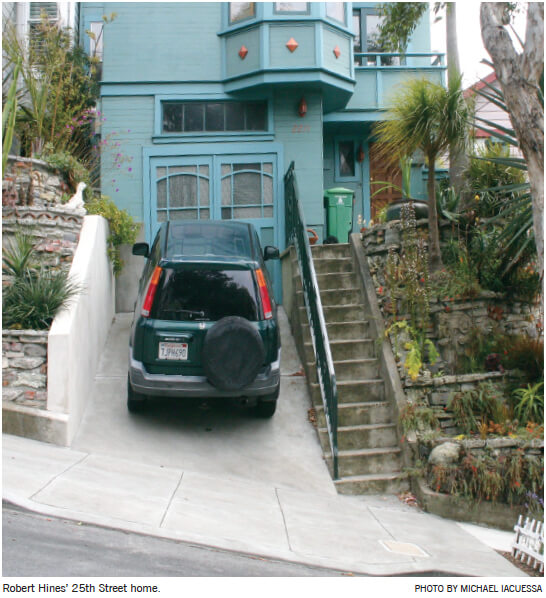It started as a simple home improvement project. For 35 years, Robert Hines had a driveway and a garage, but no curb cut. Pulling his automobile onto his property meant the car muffler would scrape against the pavement. When Hines finally got around to pulling a permit to construct the curb cut in 2013, he stirred up municipal matters he’d never anticipated.
In 2014, the San Francisco Department of Public Works informed Hines that the first 14.5 feet of his front yard was owned by the City, and that to access his property he’d be assessed an annual $120 fee. “It was a shock to us that it wasn’t our property,” bemoaned Hines, who owns 2211 25th Street with his partner, John Seemann. “Any reasonable person would assume from the sidewalk in would be your property.”
Hines began writing letters – lots of them – to the San Francisco Board of Supervisors, District 10 Supervisor Malia Cohen, the Assessment Appeals Board and various other City agencies. Over two years he’s had no response from any of them.
“I’m just the little guy and they don’t care,” he reasoned. “The big picture is developers, ballparks.”
The fee, levied for what’s called a “minor sidewalk encroachment,” stems from an ordinance passed by the Board of Supervisors in 2005. Any permit pulled after August of that year involving a public right of way is subject to the law, explained Carlos Jennings, a junior analyst with the Bureau of Street Use and Mapping. Anyone with a driveway built before that date doesn’t have to pay the charge. “The justification is that you are removing private space use; public parking,” Jennings said. “Sort of renting the curb from the City is one way to look at it.”
Nonetheless, Jennings thought it was odd for so much of Hines’ yard to be City-owned. So did Paragon realtor Tim Johnson, who hasn’t come across a similar situation in 11 years as an agent. Realtor Mary Lace, who has sold homes on Potrero Hill for Sotheby’s since 1980, had heard of cases in which the City owned sizable chunks of land from the sidewalk in, but said it was unusual.
Upon seeing a photograph of Hines’ property on Google Maps, San Francisco municipal planner Tina Chang recognized it as triggering section 132 of the Planning Code. “Usually a house is not set back so far,” she said, noting the distance of Hines’ home to the street. The code, which would take a seminar in municipal law to fully comprehend, requires setbacks to be equal or the average of the two adjacent homes. In order to ensure that occurs as much as possible the City can claim up to 15 feet from the sidewalk for public use.
According to Chang, such situations are more common on up-sloping lots, because homes on those locations may need to be built along less customary lines. In fact, when he purchased the land Hines had to stabilize a sinking embankment to preserve the house, the instability probably being the reason the structure was built further from the street. Part of that embankment is what’s deemed public property now, and what prompted Hines’ confusion.
When the fee was explained to him by DPW two years ago Hines couldn’t comprehend it. Besides the obvious – the parking place removed from the public was where he parked his car anyway – his bill also lists his stairs and “planters,” essentially the embankment, as encroaching on that 14.5 feet of City property. “The $120 is not going to break me, but it’s the injustice of it,” he said. “They are charging me to use the stairs to get into my house. Why don’t they just put in a turnstile and I can pay a quarter every time I go in?”
DPW told Hines that if he could prove the stairs pre-existed when he pulled his curb cut permit his bill would be adjusted. When he produced a dated photo taken just after buying the home he was told that the agency didn’t accept photos as proof, and needed stair construction permits. Hines has few of those records. In 1978, the property was under foreclosure; he and Seemann had to go to court to fend off creditors to get the purchase approved. Not only were permits excluded from the sale, according to Johnson disclosure of the public use requirement might not have been necessary either.
Hines is particularly riled, however, that no one has returned his requests for a better explanation, although he quipped, “I don’t know how you explain the unexplainable.”
Adding more to the oddity surrounding the land, on the San Francisco Property Information Map – the go-to map used by City planners – there’s a blank space where the footprint of Hines’ home should be. The structure, built in 1907, appears on historical maps, but those are unofficial. No one had an explanation for that one.



